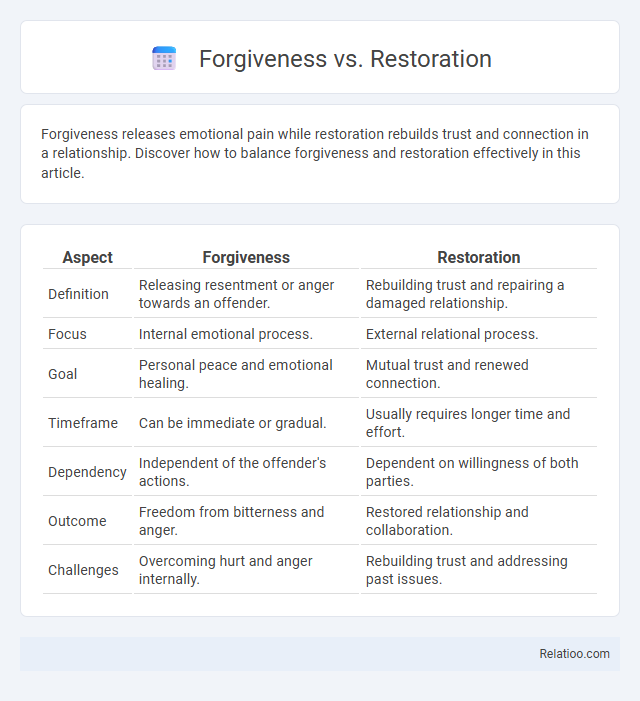Forgiveness releases emotional pain while restoration rebuilds trust and connection in a relationship. Discover how to balance forgiveness and restoration effectively in this article.
Table of Comparison
| Aspect | Forgiveness | Restoration |
|---|---|---|
| Definition | Releasing resentment or anger towards an offender. | Rebuilding trust and repairing a damaged relationship. |
| Focus | Internal emotional process. | External relational process. |
| Goal | Personal peace and emotional healing. | Mutual trust and renewed connection. |
| Timeframe | Can be immediate or gradual. | Usually requires longer time and effort. |
| Dependency | Independent of the offender's actions. | Dependent on willingness of both parties. |
| Outcome | Freedom from bitterness and anger. | Restored relationship and collaboration. |
| Challenges | Overcoming hurt and anger internally. | Rebuilding trust and addressing past issues. |
Understanding Forgiveness: Definition and Core Principles
Understanding forgiveness involves recognizing it as a deliberate decision to release resentment and anger towards someone who has caused harm, without necessarily erasing the wrongdoing. Core principles of forgiveness include empathy, emotional healing, and the acknowledgment of pain, fostering inner peace and improved mental health. Forgiveness differs from restoration, which entails rebuilding trust and relationships, and from reconciliation, which requires mutual agreement and interaction between parties.
What is Restoration? Meaning and Importance
Restoration refers to the process of rebuilding trust, repairing relationships, and reinstating what was lost or damaged. It goes beyond forgiveness by actively working to heal wounds and foster reconciliation between parties. Your commitment to restoration is essential for creating lasting peace and strengthening emotional bonds.
Key Differences Between Forgiveness and Restoration
Forgiveness involves letting go of resentment and the desire for punishment without necessarily rebuilding the relationship, while restoration requires actively repairing trust and reconnecting emotionally or practically. Forgiveness can be a personal, internal process that benefits the forgiver's emotional health, whereas restoration demands mutual commitment and consistent effort from all parties. Understanding these differences highlights that forgiveness is often a prerequisite for restoration but does not guarantee it.
The Role of Forgiveness in Personal Healing
Forgiveness acts as a crucial catalyst in personal healing by allowing individuals to release resentment and emotional pain, fostering inner peace and mental clarity. Unlike restoration, which involves rebuilding trust and repairing relationships, forgiveness primarily focuses on emotional liberation regardless of reconciliation. Embracing forgiveness can lead to profound psychological benefits, including reduced stress, anxiety, and depression, thereby promoting holistic well-being.
Can Restoration Occur Without Forgiveness?
Restoration can occur without forgiveness, but the process is often incomplete or fragile because true healing requires emotional reconciliation that forgiveness provides. Forgiveness releases resentment and enables trust-building, creating a foundation for lasting restoration in relationships. Your ability to restore connections without forgiveness may address practical issues but often leaves unresolved emotional wounds that hinder full recovery.
The Process of Forgiving: Steps and Challenges
The process of forgiving involves acknowledging the hurt, understanding the offender's perspective, and making a conscious decision to release resentment, which can be emotionally challenging and requires time and patience. Restoration goes beyond forgiveness by rebuilding trust and repairing relationships through open communication and mutual effort, which may not always be possible or desired. Differentiating forgiveness from restoration helps individuals set realistic expectations and focus on emotional healing, even when relationships cannot or should not be restored.
Restoring Relationships: How It Works and When It’s Possible
Restoring relationships involves rebuilding trust and open communication after conflict, which can only occur when both parties are willing to engage in honest dialogue and emotional vulnerability. Forgiveness is a crucial step in this process, as it releases resentment and creates space for healing, but restoration requires consistent effort, empathy, and accountability to rebuild connection. You can restore relationships when mutual respect is re-established, boundaries are honored, and both individuals commit to positive change and understanding.
Situations Where Forgiveness Does Not Lead to Restoration
Forgiveness involves releasing resentment or anger toward someone who has caused harm, but it does not always lead to restoration, which requires rebuilding trust and repairing relationships. Situations such as ongoing abuse, repeated betrayal, or unresolved toxic behaviors often prevent restoration despite forgiveness being granted. In these cases, maintaining boundaries or distance becomes necessary to protect one's emotional and physical well-being, highlighting that forgiveness is a personal process independent of reconciliation.
Emotional and Psychological Benefits of Both Forgiveness and Restoration
Forgiveness alleviates emotional burdens by reducing anger, resentment, and stress, fostering inner peace and improved mental health, while restoration rebuilds trust and strengthens relationships through open communication and empathy. Both processes enhance psychological well-being by promoting healing, reducing anxiety, and encouraging emotional resilience. Embracing forgiveness alongside restoration leads to comprehensive emotional recovery and healthier interpersonal dynamics.
Practical Tips for Navigating Forgiveness and Pursuing Restoration
Navigating forgiveness involves acknowledging personal emotions and setting clear boundaries to foster genuine healing without rushing reconciliation. Pursuing restoration requires consistent communication, mutual accountability, and rebuilding trust through transparent actions that demonstrate commitment. Practical tips include practicing empathy, seeking professional counseling if needed, and prioritizing self-care while allowing time for growth in relationships.

Infographic: Forgiveness vs Restoration
 relatioo.com
relatioo.com